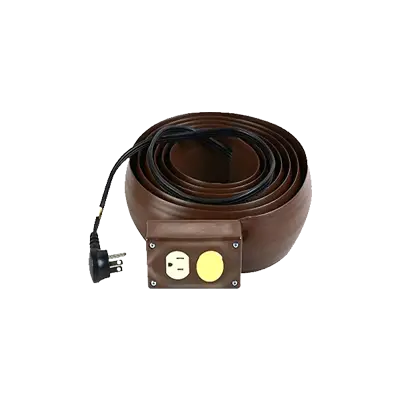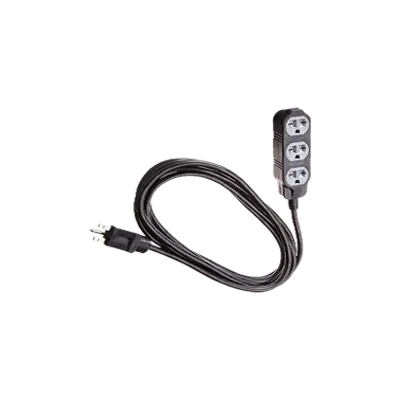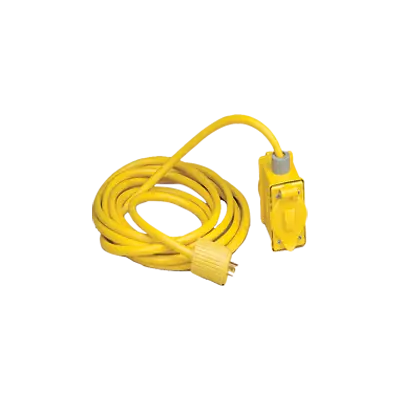Call +(254) 703 030 000 / 751 483 999 / 721 704 777
- Home
- Electrical
- Extension Cords Power Strips Cord Reels
- Extension Cords
.....Read More
Frequently Asked Questions
What gauge extension cord do I need?
To determine the appropriate gauge for an extension cord, consider the following factors:
1. **Amperage Requirement**: Identify the amperage of the device you plan to power. This information is usually found on the device's label or in the user manual.
2. **Cord Length**: The longer the extension cord, the thicker it needs to be to prevent voltage drop. Longer cords require lower gauge numbers (thicker wires).
3. **Gauge Selection**:
- For cords up to 25 feet:
- 16-gauge for up to 10 amps
- 14-gauge for 11-13 amps
- 12-gauge for 14-15 amps
- For cords 50 feet:
- 14-gauge for up to 10 amps
- 12-gauge for 11-15 amps
- For cords 100 feet:
- 12-gauge for up to 10 amps
- 10-gauge for 11-15 amps
4. **Environment**: Consider the environment where the cord will be used. Outdoor or heavy-duty use may require a cord with a thicker jacket and additional insulation.
5. **Safety Standards**: Ensure the extension cord meets safety standards such as UL (Underwriters Laboratories) or ETL (Intertek) certification.
By considering these factors, you can select an extension cord that safely and efficiently meets your power needs.
How long can an extension cord be before it loses power?
The length at which an extension cord begins to lose power depends on several factors, including the wire gauge, the current being drawn, and the voltage of the system. Generally, the longer the extension cord, the greater the resistance, which can lead to voltage drop and power loss.
1. **Wire Gauge**: Thicker wires (lower gauge numbers) can carry more current over longer distances with less resistance. For example, a 12-gauge wire can handle more current over a longer distance than a 16-gauge wire.
2. **Current and Voltage**: The amount of current (measured in amperes) and the voltage of the system also affect how far power can be transmitted without significant loss. Higher current and lower voltage systems are more susceptible to power loss over long distances.
3. **Voltage Drop**: A voltage drop of more than 5% is generally considered unacceptable for most applications. For a 120-volt system, this means a drop of 6 volts is the maximum allowable.
4. **Practical Limits**: For a 16-gauge extension cord, a practical limit might be around 50 feet for a 10-amp load. For a 12-gauge cord, you might extend this to 100 feet for the same load without significant power loss.
5. **Safety and Efficiency**: Beyond power loss, longer cords can pose safety risks, such as overheating and fire hazards, if not properly rated for the load.
In summary, while there is no fixed length at which an extension cord will lose power, careful consideration of the wire gauge, load, and system voltage is necessary to minimize power loss and ensure safety.
Can I use an indoor extension cord outside?
No, you should not use an indoor extension cord outside. Indoor extension cords are designed for use in controlled environments where they are not exposed to moisture, temperature extremes, or physical damage. They lack the necessary insulation and protective features to withstand outdoor conditions. Using an indoor extension cord outside can lead to electrical hazards such as short circuits, electric shocks, or fires due to exposure to rain, snow, or direct sunlight. For outdoor use, always choose an extension cord specifically labeled for outdoor use, as these are built to handle the rigors of outdoor environments safely.
How do I know if an extension cord is safe?
To determine if an extension cord is safe, consider the following factors:
1. **Certification**: Look for safety certifications such as UL (Underwriters Laboratories), CSA (Canadian Standards Association), or ETL (Intertek). These indicate the cord has been tested for safety standards.
2. **Condition**: Inspect the cord for any signs of damage, such as fraying, cracking, or exposed wires. A damaged cord is a fire and shock hazard.
3. **Gauge and Length**: Ensure the cord's gauge (thickness) is appropriate for the intended use. Lower gauge numbers indicate thicker wires, which can handle more current. Longer cords require thicker wires to prevent voltage drop.
4. **Load Capacity**: Check the cord's amperage rating and ensure it matches or exceeds the power requirements of the devices you plan to connect. Overloading can cause overheating and fires.
5. **Indoor vs. Outdoor Use**: Use cords specifically rated for outdoor use if needed. Outdoor cords are designed to withstand weather conditions and have additional insulation.
6. **Grounding**: Use a three-pronged cord for devices that require grounding. This reduces the risk of electric shock.
7. **Plug and Socket Condition**: Ensure the plug and socket are in good condition, with no signs of burning or melting. They should fit snugly into outlets.
8. **Usage Environment**: Avoid running cords under carpets, through doorways, or in high-traffic areas where they can be damaged or cause tripping hazards.
9. **Temperature Rating**: Check the cord's temperature rating to ensure it can handle the environment where it will be used, especially in high-heat areas.
10. **Proper Storage**: Store cords properly when not in use to prevent damage. Avoid tightly coiling or kinking the cord.
By considering these factors, you can ensure the extension cord is safe for use.
What is the difference between a 2-prong and a 3-prong extension cord?
A 2-prong extension cord has two flat parallel pins and is designed for devices that do not require grounding. It is typically used for double-insulated appliances, which have extra insulation to protect against electric shock. These cords are suitable for light-duty applications, such as lamps, clocks, or small kitchen appliances, where grounding is not necessary.
In contrast, a 3-prong extension cord includes an additional round pin, known as the ground pin, along with the two flat parallel pins. This ground pin provides a path for electrical current to safely dissipate into the earth in case of a fault, reducing the risk of electric shock. The 3-prong design is used for devices that have metal parts or are more susceptible to electrical faults, such as power tools, computers, and large appliances.
The key differences between the two types of cords are safety and application. A 3-prong cord offers enhanced safety due to its grounding capability, making it suitable for heavy-duty or high-risk electrical devices. It is important to match the extension cord type with the device's plug and power requirements to ensure safety and functionality. Using a 2-prong cord for a 3-prong device can compromise safety, while using a 3-prong cord for a 2-prong device is generally safe but unnecessary.
How much power can an extension cord handle?
The power an extension cord can handle depends on several factors, including its gauge (thickness of the wire), length, and the voltage of the electrical system it is connected to.
1. **Gauge**: The American Wire Gauge (AWG) system is used to denote the thickness of the wire. Lower AWG numbers indicate thicker wires, which can handle more current. Common household extension cords range from 16 AWG to 10 AWG. For example, a 16 AWG cord can typically handle up to 13 amps, a 14 AWG cord can handle up to 15 amps, and a 12 AWG cord can handle up to 20 amps.
2. **Length**: The longer the extension cord, the more resistance it has, which can reduce the amount of power it can safely carry. Longer cords require a thicker gauge to handle the same amount of power as shorter cords.
3. **Voltage**: Most household extension cords are designed for standard 120-volt systems. The power capacity (in watts) can be calculated using the formula: Power (Watts) = Voltage (Volts) x Current (Amps). For example, a 14 AWG cord on a 120-volt system can handle up to 1,800 watts (120 volts x 15 amps).
4. **Usage**: It's important to consider the type of devices being powered. High-wattage appliances like space heaters or air conditioners require cords with higher power ratings. Always check the manufacturer's specifications for both the extension cord and the devices being used.
5. **Safety**: Overloading an extension cord can cause overheating and potentially lead to fires. Always ensure the cord is rated for the intended use and avoid daisy-chaining multiple cords together.
In summary, select an extension cord with the appropriate gauge and length for your needs, and ensure it matches the power requirements of your devices.
Can extension cords be used permanently?
Extension cords are not designed for permanent use. They are intended for temporary solutions to provide power to devices that are not near an outlet. Using them permanently can pose several risks and issues:
1. **Safety Hazards**: Extension cords can overheat if used for extended periods, especially if they are not rated for the power load they are carrying. This can lead to fires or electrical shocks.
2. **Wear and Tear**: Over time, extension cords can suffer from wear and tear, leading to exposed wires or damaged insulation. This increases the risk of electrical hazards.
3. **Code Violations**: Many building codes and safety regulations prohibit the permanent use of extension cords. They require that permanent wiring solutions, such as additional outlets or hardwired connections, be used instead.
4. **Tripping Hazards**: Extension cords can create tripping hazards if they are run across floors or walkways. This is especially dangerous in high-traffic areas.
5. **Limited Capacity**: Extension cords have a limited capacity and are not suitable for high-power appliances. Using them for such devices can cause the cord to overheat and fail.
6. **Aesthetic and Practical Concerns**: Extension cords can be unsightly and impractical for permanent use, as they can clutter spaces and make cleaning difficult.
For permanent solutions, it is advisable to install additional electrical outlets or use power strips with built-in circuit breakers. These options are safer, comply with electrical codes, and provide a more reliable power source. Always consult a licensed electrician for permanent electrical installations to ensure safety and compliance with local regulations.


